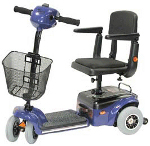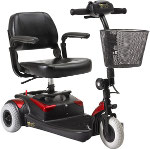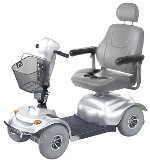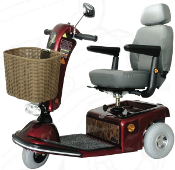The Wheelchair Guide
Your Wheelchair and Mobility Scooter Resource
Mobility Scooters for Seniors
Friday, May 22nd, 2009 at 12:10 pm
 One of the most popular, if not the most popular, mobility aids for seniors is the mobility scooter. Mobility scooters were first developed during the 1960′s and share many similarities with the electric wheelchair.
One of the most popular, if not the most popular, mobility aids for seniors is the mobility scooter. Mobility scooters were first developed during the 1960′s and share many similarities with the electric wheelchair.
An electric motor propels the mobility scooter and it uses one or more batteries, much like a power chair. Often they also share a similar, if not identical captains chair, which includes the same types of features, such as a reclining back, electric lifting system, and swivel controls to make exiting the mobility vehicle much easier.
Like the other two kinds of mobility vehicles, mobility scooters also feature anti-tip casters to prevent the device from tipping over backwards.
However, the physical design of a mobility scooter is actually much different than that of a wheelchair, both electric and manual. This is because they have a much longer wheel base and the captains chair is mounted on the rear of the base.
Mobility Scooter Control Systems
Instead of an armrest mounted joystick, like is used on an electric wheelchair, a mobility scooter is controlled by a set of handlebars, which extends from the front of the scooters base. These handlebars, which are referred to as the tiller, can be adjusted to accommodate riders of different sizes. This allows the mobility scooter’s tiller to be brought closer or moved farther from the captains chair.
Depending on the model of scooter, the tiller might have a headlight, turning signals, battery meters, keyed entry, and troubleshooting gauges on it. Due to the location of the tiller, a mobility scooter can not be driven directly up to a table or desk.
Three Wheeled and Four Wheeled Mobility Scooters
There are a number of different types of mobility scooters available, with many different models available. There are also several ways that an electric mobility scooter can be classified.
One of the most common ways to classify a mobility scooter is by the number of wheels it has. 4 wheeled mobility scooters have two wheels in front and two wheels in the rear. This provides more stability, because as in the case of a rear wheel drive power chair, the weight of the occupant is spread out more evenly. This makes a 4 wheeled scooter more stable than a 3 wheeled scooter.
While a three wheeled mobility scooter might not be as stable as a four wheeled scooter, they are typically much more manuverable and have a turning radius that is considerably smaller than that of a four wheeled scooter. This makes a 3 wheeled scooter preferrable for indoor use. They are also typically lighter in weight.
Different Mobility Scooters for Different Uses
The other way that mobility scooters are classified is by their intended use. For example, there are travel scooters, heavy duty scooters, and traditional scooters.
 Travel scooters are designed to be as light weight as possible, so they can be taken on vacation or away from the home. They are also designed so that they can be easily disassembled, with all of the pieces being a manageable weight. Often the heaviest piece weighs less than 30 pounds, so most people are able to disassemble it and place it in the trunk of their car or rear seat of their vehicle.
Travel scooters are designed to be as light weight as possible, so they can be taken on vacation or away from the home. They are also designed so that they can be easily disassembled, with all of the pieces being a manageable weight. Often the heaviest piece weighs less than 30 pounds, so most people are able to disassemble it and place it in the trunk of their car or rear seat of their vehicle.
Most travel scooters are three wheeled, as this helps reduce the overall weight of the electric scooter. They also have fewer features, like a scaled back captains chair and no running lights, to further save weight.
Travel scooters do not have the same weight support or range that you could expect from other scooters, but for vacation they can be a great choice.
 On the opposite side of the spectrum you have heavy duty scooters. A heavy duty mobility scooter is designed to be as rugged and durable as possible. They have the highest weight support, usually feature reinforced bumpers, larger tires, and are packed with features. They are designed, as the name implies, to be used over rough outdoor terrain. Typically, most are four wheeled as this provides the most stability, but there are a few three wheeled heavy duty scooters.
On the opposite side of the spectrum you have heavy duty scooters. A heavy duty mobility scooter is designed to be as rugged and durable as possible. They have the highest weight support, usually feature reinforced bumpers, larger tires, and are packed with features. They are designed, as the name implies, to be used over rough outdoor terrain. Typically, most are four wheeled as this provides the most stability, but there are a few three wheeled heavy duty scooters.
Heavy duty scooters also usually have a very high top speed, large per charge range, and can be a great deal of fun to drive.
While great for outdoor use, since a heavy duty scooter is typically much larger than other electric scooters, it can not be used in some indoor situations and has a much larger turning radius. It also weighs a great deal more so taking it apart and placing it in a vehicle might not be an option for most people. Heavy duty electric scooters are also the most expensive type of mobility scooter.
 All other mobility scooters fall into the category of traditional scooter. These come in a variety of sizes and while they have many more features than a travel scooter, they have fewer than a heavy duty scooter. Typically though, they will have things like running lights. They come in either 3 wheeled or 4 wheeled designs.
All other mobility scooters fall into the category of traditional scooter. These come in a variety of sizes and while they have many more features than a travel scooter, they have fewer than a heavy duty scooter. Typically though, they will have things like running lights. They come in either 3 wheeled or 4 wheeled designs.
When compared to travel scooters, traditional scooters offer increased weight support, range, top speed, stability, and durability. Like heavy duty scooters, the weight of a traditional scooter often makes disassembling it not an option, because the lightest piece can often weigh well over 70 pounds.
Seniors and Mobility Scooters
Price wise the cost of a mobility scooter usually falls in the middle, between a manual wheelchair and electric wheelchair. They are easy to use and have a greet range, so can be a good choice for a senior who has difficulty walking.
Due to the location of the tiller, you are not able to drive a mobility scooter directly up to a table, which means that some mobility is required of the user in order to get the most benefit out of a mobility scooter.
For someone who can walk, but not for extended periods of time, a mobility scooter would be a good choice. However, for someone who can not walk, a mobility scooter might not be a good choice.